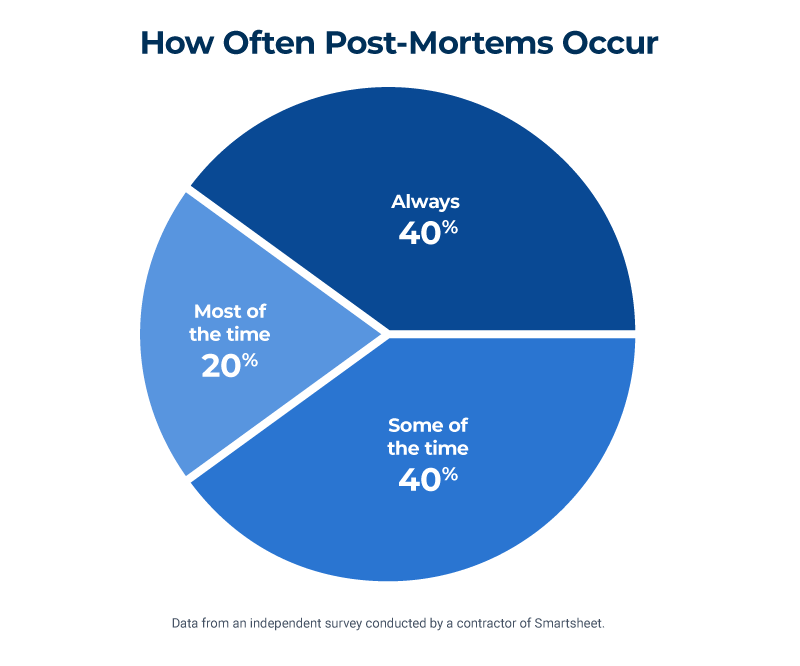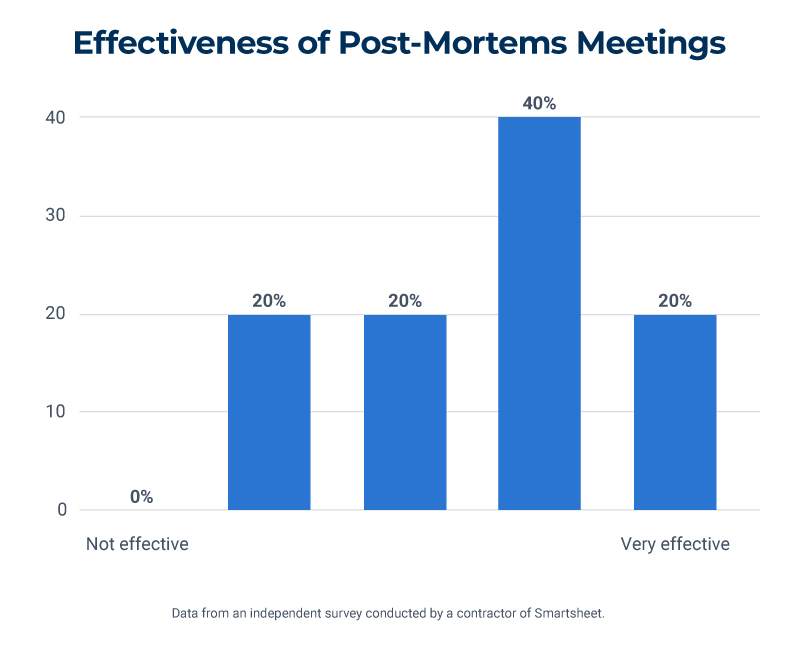What Is a Post-Mortem?
A post-mortem is a process that helps improve projects by identifying what did and didn’t work, and changing organizational processes to incorporate lessons learned. The Project Management Book of Knowledge (PMBOK) refers to this activity as “lessons learned.”
Post-mortem meetings typically take place at the end of a project. However, during longer projects, you may hold post-mortems regularly (such as monthly, quarterly, or annually) to allow for course corrections and to ensure that you don’t overlook incidents.
Post-mortems are more than just fact-finding. In fact, the most important functions of a post-mortem are to drive process improvements and to promote best practices to repeat any successes.
This meeting is an integral part of the project management process, but teams sometimes skip it due to time and resource constraints, or the sense that it doesn’t contribute to the bottom line. Grant Aldrich, Founder of OnlineDegree.com, explains, “The post-mortem meaning is perhaps the most important aspect of project management and improving your processes. Yet, it's commonly the most neglected. It provides an incredibly important period to reflect on how things were done and to make improvements. Sadly, I think that that's rarely utilized in most organizations. All that they do once the project is concluded is rush to get people to transition to the next one because that translates to revenue.”
Approach the post-mortem as an open forum in which anyone involved in the project can bring up issues and successes for discussion. Examine all aspects of the project lifecycle during the post-mortem, from planning thorough closure, in order to find areas for improvement and processes to repeat in future projects. In addition to the project lead and project team, project stakeholders and clients should also participate in the discussion — doing so will help reinforce teamwork by having people continue to work together toward a common goal, regardless of their individual role.
What Is a Post-Mortem in Business?
In business, a post-mortem is a part of risk management and helps drive continuous improvement by adopting best practices. The post-mortem performed at the end of a project determines what went well and what went poorly so you can use those lessons going forward.
For more resources to create and support a culture of continuous improvement for your business, choose from a variety of free post-mortem templates.
Alternative Names for Post-Mortem Meetings
Many organizations use a different name to refer to the function of a post-mortem meeting. Below are some possible alternatives:
- Debrief: This term has its origin in the military, where they use it for post-mission reviews.
- Retrospective: Agile project management uses this term for meetings that occur at each stage of project completion.
- Project Wrap-Up: This is a name used by many project managers.
- Lessons Learned: The Project Management Institute (PMI) uses this terminology.
- After-Action Review: This term is generally applied to IT/DevOps reviews.
- Critical Incident Review: IT/DevOps teams also often use this term for their reviews.
Project Post-Mortem vs. Incident Post-Mortem
The post-mortem is also a key part of risk management. A company can lower or mitigate risk in future projects by analyzing what went wrong in past projects and making changes to processes and procedures.
There are two main situations where post-mortem meetings occur. The first (as mentioned above) is project related. The second is to analyze DevOps/IT incidents, such as a server crash or a website being down. While the main goal of both types of post-mortems is to find root causes, there are some differences.
| Project Post-Mortem | Incident Post-Mortem | |
|---|---|---|
| Timing | Scheduled at the end of the project or at regular intervals during the project | Ad-hoc, after an incident has been resolved |
| Who’s Involved | Project team and management stakeholders | Anyone who caused, was impacted by, or responded to the incident |
| Results | Improvements to processes and procedures to make future projects run more smoothly | Improvements to processes, procedures, and security to prevent the issue from happening again |
For help with planning and creating reports, download free project post-mortem templates and IT incident templates.
Project managers usually organize post-mortems. The meetings are useful in many situations and beneficial for many groups, including marketing teams, agencies, information management, and issue management.
Timing is important when scheduling post-mortems. Peoples’ memories can be short, so it’s important to schedule meetings as soon as the project is complete or you’ve resolved the incident.
In a small survey of project managers, 100 percent of the respondents said they had led post-mortem meetings after their projects:
- 40% always have them
- 20% have them most of the time
- 40% have them some of the time
Agile Retrospective vs. Project Post-Mortem
In Agile project management, the term retrospective is used to refer to a similar activity, which occurs after each software development iteration. Here’s how the two differ:
| Project Post-Mortem | Agile Retrospective | |
|---|---|---|
| Timing | Scheduled at the end of the project or at regular intervals during the project | Once per iteration |
| Who’s Involved | Project team and management stakeholders | Project team |
| Focus | Successes and failures that occurred during the project | Experience during the previous iteration |
| Results | Proposed changes to processes to improve the results of future projects | Action items for incremental improvement for the next iteration |
How to Conduct a Post-Mortem
During a post-mortem meeting, the group will discuss what went wrong and what went right during a project. They’ll post their findings to a project timeline, and recommend ways to repeat successes and avoid issues in future projects.
Typically, the project leader gathers data about the project, including feedback from stakeholders and team members, to create the meeting agenda. During the meeting, the group reviews the project and creates a timeline that illustrates major milestones and events, and then adds successes and failures.
Creating the timeline allows the team to dig into each problem and success, document the root cause of each, and determine how to avoid or repeat it. Based on the uncovered causes, the team develops action items to improve processes and repeat the successes.
Check out our collection of free post-mortem templates, including checklists, reports, and a meeting template to help run your next meeting, and visit our in-depth guide on conducting a successful post-mortem meeting.
What a Successful Post-Mortem Can Accomplish
A post-mortem has many benefits, whether conducted for a project or an IT incident. The process can help improve communication, collaboration, and workflows, which make for a more efficient and successful organization.
Post-mortems can help future projects run more smoothly in the following ways:
- Improve Internal Processes: Examining processes when problems occur exposes the system’s weaknesses. Apply the lessons learned in a post-mortem to repair those pitfalls and strengthen your procedures.
- Streamline Workflows: Issues uncovered in post-mortems can include workflow issues that you can eliminate in future projects.
- Foster Team Collaboration: The format of post-mortem meetings reinforces a common purpose and teaches teams to learn to work together.
- Improve Efficiency: A post-mortem can reveal duplicate work, clunky process steps, and other inefficient tasks.
- Boost Communication: A common problem in projects is a lack of good and timely communication. One of the key steps in the post-mortem process is to communicate the findings from the meeting and let interested parties know when each action item is finished.
- Learn from Mistakes: The most useful part of the post-mortem is identifying what’s gone wrong and looking for ways to prevent those problems from reoccuring.
- Get Closure: Communicating when an action item is complete lets team members know that issues they uncovered have been addressed.
- Share Information: Sharing the lessons from a post-mortem with other teams working on similar projects helps everyone in an organization.
- Improve Morale: Post-mortems allow people to call out problems and ensure they get addressed. The progress boosts morale because people know they can directly contribute to the quality of their workplace and work product.
- Celebrate Successes: In addition to analyzing issues, the post-mortem allows teams to call out their victories, which contributes to improved morale and team cohesion.
- Change Course:
For longer projects, scheduling a number of mid-project post-mortems allows the team to implement fixes that will help the rest of the project run smoothly. Paula Cizek, Chief Research Officer at nobl.io, an organizational design firm, says, “If you're doing post-mortems on a regular basis, you have a chance to course correct. If you wait until the end of a project, there's a lot that can change; a lot that can be done better, quickly. That's why we really recommend doing them on a regular basis”
In a small survey of project managers, 60 percent of respondents said that on a scale from one (not effective) to five (extremely effective), post mortems are very or extremely effective at driving process improvements.
What Is a Post-Mortem Analysis?
A post-mortem analysis is a process in which you summarize what went wrong (and should be fixed) in a project, as well as what went well and should be repeated. The analysis also produces action items and who is responsible for each.
The data being analyzed during the post-mortem will include inputs from a number of sources, including feedback from the project team and an evaluation of the project’s results. The analysis results should contain the following:
- A full list of issues to address (and the action items stemming from each issue)
- Crucial issues that held the project back
- Successes that helped the project succeed
- Any non-obvious lessons that require action
- The person accountable for implementing each action item
One effective tool is the Five Whys analysis. This technique guides you to ask “Why?” five times to isolate the root cause of an issue. You can read more about the Five Whys technique in this article on blameless post-mortem meetings. For general information about post-mortem meetings, you can also read our "How to Run a Post-Mortem Meeting" article.
Pre-Mortems and When to Perform Them
A pre-mortem is a strategy that uses the post-mortem framework, but occurs early in the planning process, prior to starting a project. Meeting participants imagine that the project is complete but has gone badly, and propose likely failures and possible causes.
The team uses the results of the exercise to work backward and make changes to processes in order to prevent the imagined failures from occurring. During the meeting, encourage participants to consider reasons for errors that they wouldn’t bring up normally, what they’re worried about before project initiation, and blind spots from past projects. Team members should be specific when describing possible points of failure.
What you need to think about during the pre-mortem will vary based on the type of project, but they will probably concern the project plan, resources, tasks, timing, and documentation. Here are some example pre-mortem questions:
- What’s missing from the project plan?
- What could slow down the project or cause you to miss the launch deadline?
- What if we lose key people during the project?
- Who owns the biggest areas of risks?
- Have you accounted for all critical tasks?
- Will we have access to all the resources we’ll need when we need them?
- Do we have the right team members for each role?
- Is the schedule realistic?
- Is there room in the schedule for delays?
- What if we lose data due to a server crash?
- Is the documentation plan sufficient?
After you’ve generated a list, you can winnow it down by eliminating problems that are unlikely (for example, your company going bankrupt), those that wouldn’t be show-stoppers (the shipment of t-shirts for the launch party is late), and any items you can’t do anything about (a meteorite hitting the construction site).
Conversely, you can also imagine that everything went right, and work your way through the process of executing on that vision. The key is to consider any possible pitfalls and what you can do to prevent them from occurring.
Types of Post-Mortem Questions
The questions you ask during a post-mortem can elicit crucial information about the project. These questions fall into the categories of planning, execution, results, and communication; below, you’ll find the goal of each category and some sample questions.
Planning questions focus on problems that arise from project planning. Digging into this initial process is valuable because planning is the foundation of the project, so improving it makes for a better project. Planning questions can be divided into the following parts:
- Project Plan: Was anything too vague in the plan? Was the plan missing any key information?
- Resources: Were tools, budgets, and team members allocated correctly? Were the needed resources adequate for the project?
- Timing: Did we build any slack into the schedule? Are the deadlines achievable and realistic?
- Tasks: Did we account for all needed tasks? Were the related dependencies and deliverables tracked for each task?
- Documentation: Was the document repository adequate for the team’s needs? Did the documentation plan help the project succeed?
Execution questions dig into the issues that arose from problems in process steps, staffing, and quality of work. These are important because they focus on the core of a project. They can be divided into the following areas:
- Workflow: Where did the workflow fail? What parts of the workflow were not properly documented?
- People: Were there any issues with the team hierarchy that resulted in problems? Were the right people assigned to the project?
- Tasks: Were there any tasks that were more difficult to complete than they should have been? What tasks were not completed properly?
- Delays: Were there adequate processes in place to deal with delays in the schedule? Did delays contribute to any issues later in the project?
- Management: Did management interfere in any way that obstructed the team’s work? Did management and the project team work together?
- Change Control: Was the change control process effective? Did it allow needed changes to be accepted and keep unneeded changes out?
Results questions deal with performance and KPIs. They are vital because look at how you’re tracking and measuring the project’s success, and ensure they make sense. They can be broken down into the following subgroups:
- Primary Goal: Was the primary goal of the project met? What hurdles made reaching the primary goal difficult?
- Secondary Goal: Did the project meet the secondary goals? What prevented them from being achieved?
- Quality: Did the project allow the team to execute with quality? Did you meet the standards outlined in the plan?
- External Performance: Was the client happy with the results? What surprised the client?
- Internal Performance: Did the success metrics make sense? Were they achievable within the constraints of the project?
Communication questions probe problems with breakdowns in communication, both internal and external. They are worth examining because projects live or die on communication. Here are some areas to explore:
- Channels: Did primary methods of communication fail in any way? Were there any inadequate channels of communication?
- Team: Were team members able to communicate when and where they needed? Did team members ever need to bypass the agreed-on communication methods?
- Manager: Was management able to effectively communicate with the team? Was the project team able to communicate with management when needed?
- Meetings: How can meetings be made more effective? Were there too many or too few meetings?
- External: Did communication with the client function as expected? What other methods of external communication need to be reviewed?
Post-Mortem Best Practices
Post-mortems help promote best practices for a company’s processes. Here are some tips for conducting effective post-mortems:
- Hold a post-mortem for every project, no matter how small.
- Schedule the post-mortem for immediately after the project ends.
- Put a post-mortem on the calendar when creating the project plan to encourage people to think about it throughout the project.
- Reschedule the post-mortem if the schedule shifts.
- Encourage participants to be constructive.
- Build-in post-mortems at regular intervals for longer or complex projects for two reasons: Memories are short and you can make course corrections along the way.
- Follow the blameless post-mortem paradigm to get to the real root cause of issues. A small survey of project managers, all respondents who had used the blameless format, agreed it was more effective than the traditional format. Sixty percent of those managers gave a response of four or five on a five point scale (five being the most effective).
- Hold a series of smaller meetings with sub-teams for large or complex projects. Then, consolidate the results from all the meetings into the final document. Jordan Kentris, a designer who has worked with major brands and has led many post-mortem meetings, suggests, “It may be really beneficial to work with those smaller teams and do a little break out. Then, work with the leaders of those departments or projects and essentially bring those forward as a secondary post-mortem.”
- Limit the amount of time each participant can present so team members raise the most important issues up first. Grant Aldrich says, “People are only given the floor for a certain amount of time. That helps someone be respectful for everyone else's time, and forces the person to really think about the most important things to bring up.”
- The project leader should model the behavior you want the team to follow.
- Invite a moderator and a note taker who aren’t part of the project team. The moderator can adhere to the schedule and rules. The note taker frees up the meeting leader to guide the discussion.
- Record the meeting so you don’t miss anything.
- Assign an owner to every action item that involves a process change. Paula Cizek says, “Before you leave the meeting, identify individuals who are responsible for making sure that the policy is implemented or incorporated into existing processes.”
Post-Mortems with Remote Teams
Ideally, you’ll have everyone in the same room for a post-mortem. With many people working from home, or with team members scattered throughout the country or around the globe, that may not be possible. While conference calls, video meetings (read some video troubleshooting tips), and screen sharing can help, there are shortcomings to these options. Collaboration software might provide some advantages.
We asked a small survey of project managers that have run both types of post-mortem meetings about the differences. Questions included, “Does the order of the agenda change when everyone is remote?” and, “What is the most important thing to do differently in a remote post-mortem compared to an in-person meeting?”
Below are a few key findings from the survey:
- All survey respondents said they didn’t change the agenda for remote meetings. So, sticking with the same order as face-to-face meetings seems to work well.
- Most respondents said finding ways to keep participants engaged is the primary change that they make when leading remote meetings as compared to in-person meetings. Recommendations include making sure that everyone has their camera on and having the moderator call on everyone when gathering input.
Streamline Post-Mortem Meetings with Smartsheet for Project Management
Empower your people to go above and beyond with a flexible platform designed to match the needs of your team — and adapt as those needs change.
The Smartsheet platform makes it easy to plan, capture, manage, and report on work from anywhere, helping your team be more effective and get more done. Report on key metrics and get real-time visibility into work as it happens with roll-up reports, dashboards, and automated workflows built to keep your team connected and informed.
When teams have clarity into the work getting done, there’s no telling how much more they can accomplish in the same amount of time. Try Smartsheet for free, today.




